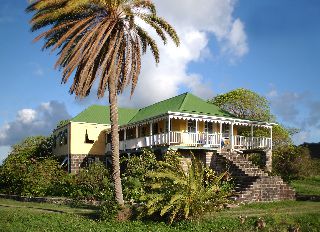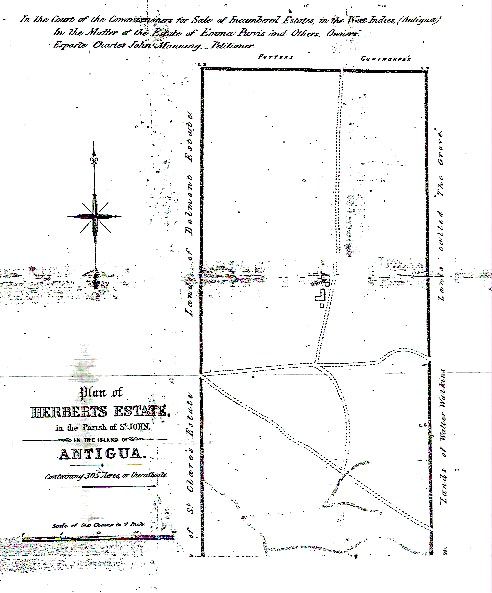About
Type: Ruin
Parish: St.John
Founding date: 1733
See on Google Maps!

Current Status
There is no longer a sugar mill nor any of the works or outbuildings of this estate, but the very large estate house still stands and is privately owned and lived in. It has a full lower story constructed of dark stone (not limestone), with a double-edged staircase in front that leads to the second story, also built of stone. The house is said to have been built in 1742 and is often referred to as “William’s” instead of Herbert’s by neighbors residing on the surrounding Potter’s Estate (#47), the Renfrew’s Estate (#21), and the Briggin’s Estate (#22).

Estate Related History/Timeline
Colonel Thomas Williams was one of the first settlers in Antigua in the mid-1600s and lived on Old Road in St. Mary’s Parish. Colonel Rowland Williams was the first white male born on the island. He married Elizabeth, the first daughter of Samuel Winthrop, who was Deputy Governor of Antigua. Rowland died in 1733. The Williams family subsequently owned Tom Moore’s (#175), the Cistern Estate, and the Claremont Estate (#177), as well as Herbert’s. The Herbert family first settled in Nevis before locating to Antigua in 1773, when Sir Richard Herbert took possession of the Williams estate and re-named it Herbert’s.
John E. Herbert was born in the early 1700s and became owner of the estate in 1790. He had two brothers, Thomas and Joseph, who became Members of the Council in Nevis. Thomas Herbert and his wife Mary had a daughter, Frances, who married William Woolward, Esq. They, too, had a daughter, Frances (Fanny) Herbert Woolward, who was born in 1761 in Nevis and was only two years old when her mother died giving birth to a son, William.
The Caribbean custom at the time among governors and sugar plantation owners was to educate their sons in England but keep the daughters at home. Fanny grew up as her father’s constant companion. He was the Senior Judge in Nevis and a partner in an export business. The West Indies were under English rule, and trade was brisk and profitable. Fanny received a good education from an English governess and became accomplished in French (the court language), painting, drawing, playing the harpsichord, singing, and dancing; everything to make her desirable, attractive, and pursued by the island’s bachelors. She promised her father to never marry anyone of whom he disapproved. Her first husband was Josiah Nisbet MD, in Nevis, a friend of her father’s and an eccentric doctor with whom she had one son. She was widowed at the age of 22 and subsequently married Rear Admiral Horatio Nelson, Captain of His Majesty’s ship Boreas, on March 11, 1787. She was Nelson’s wife for 18 years, of whom he said, “I find my domestic happiness perfect. I am possessed of everything that is valuable in a wife.” However, he fell in love with Lady Emma Hamilton and became estranged from Fanny, who never ceased to love Nelson. She supposedly slept with a miniature of him under her pillow, which she kissed every night. Excerpted from caribbean-beat.com/issue-32/lord-nelsons-west-indian-widow-fanny-nesbit
British Parliamentary Papers P. 309, describe a claim (T71-877) made by William Burnthorn, owner of Herbert’s at the time (1829-1843) as owner-in-fee. His claim was counter-claimed (T71-250) by John Ewart & Co., brokers and commission merchants in Liverpool. Their claim shows William Burnthorn as a resident proprietor in the 1832 return, and an agent for Earl Crawford & Lindsay. In the Burnthorn ancestry site, there is a list of slaves, by name and age, owned by William Burnthorn. He is listed as “born about 1732, residence 1817, Antigua.”
Also in 1829 (September 12) there was another counter-claim (T71-1230) filed by Charles John Manning, dated 09/22/1829: “indenture registered in Antigua April 17, 1830, made between GHR, W. S. Rose, Frances Theodora Rose and Charles John Manning: Little Duers (#90) conveyed to Charles John Manning. The name of Charles John Manning used by Manning and Anderdon as trustee in purchase, estate and slaves conveyed to the said Charles John Manning without his knowledge or consent.” Manning was a West Indian merchant and received compensation T71-877 (noted above), Antigua claims 69, for Lower & Upper Walrond (#79) and Little Duers (#90) estates. Little Duers conveyed to Charles John Manning. Manning and Anderdon ultimately went bankrupt, and their creditors brought suit vs. Charles John Manning in Antigua for supplies.
In 1833, when the British Parliament abolished slavery, the Herbert’s Plantation received a Legacy payment (Antigua 116) of £1,137. 15s. 6p. for granting freedom to 56 enslaved. William Burnthorn was the awardee; John Ewart was unsuccessful. The Plantation received an additional Legacy payment (Antigua 117) of £622. 15s. 1p. for freeing 34 enslaved. William Coles, John Henry Roper, Francis Thwaites, Esq., and John Trecothick the younger were owners in fee.
“At a meeting of the Council of Antigua held this day, Dr. Anthony Musgrave presented his diploma from Edinburgh University, dated June 24th, 1814, and received a license to practice.” Source unknown.
Dr. Musgrave became owner of the Herbert’s Estate in 1843, as listed below in The Ownership Chronology.
An 1860 petition was filed with “the Court of the Commission for Sale of Encombered Estates in the West Indies (Antigua). In the Matter of the Estate of Emma Purvis and Others, Owners. Exparte Charles John Manning, Petitioner.” The map provided by the Commission shows Potter’s and Gunthorpe’s on the northern boundary, St. Clare’s and Belmont Estate to the east, and on the western boundary the lands of Walter Watkins and lands called “The Grove.” Nothing appears on the map regarding the southern boundary of Herbert’s Estate.
By 1872, Emma Purvis owned this estate, along with Drew’s Hill (#18) and Belmont’s (#19), for a total acreage of 788. The Herbert’s sugar mill also had been converted from wind power to steam.
When John MacDonald took possession of the Estate in 1891, it was producing annual revenue of £200, but by 1892 the revenue had declined to only £50. The estate passed from MacDonald to George Alan and Kathryn Dora Macandrew. George was the City’s or Tomlinson’s estate agent. Douglas, son of George & Kathryn, and his wife Mary Macandrew, rented Herbert’s from John I. Martin in the 1940s, and their daughter, Marguerite, supplied the photograph of the plantation house. Wendy Gardner and Antigua newspaper extracts.
In 1918, Emmanuel O. Camacho was the sole owner of A. J. Camacho & Co., a merchant business formed by his father Antonio Joseph Comacho. Emmanuel owned Briggin’s (#22), Herbert’s (#20), and Dunning’s (#190), presumably inherited from his father.
Sid Turock, who occupied the estate house in 1945 with his wife, Norma, was “a master furniture builder and joiner. He restored antiques and had a wonderful personal collection. Herbert’s was a showplace in his time.” Selvyn Walker, “Not A Drum Was Heard”.
Raymond Raeburn, from the U.K., purchased the old estate house plus three acres of land in 1986, to be joined later by Marina MacLean. Upon Raymond’s death, Marina continued the upkeep of the historic building, which was featured in a BBC television documentary when the producers were searching for an estate house dating from the mid-1700s, the time of England’s Industrial Revolution. The documentary showed how the revenue from sugar helped to fuel England’s industrial revolution.
The Antigua Sugar Factory Ltd. estimated cane returns in 1941 from the Herbert’s and Briggin’s (#22) estates at 1,060 tons; tons of cane actually delivered, 1,581.
Enslaved People’s History
Based on contemporary research, we have little information to share about the enslaved peoples from this plantation at this time. They probably had at maximum of 197 people working at that plantation. A fact of interest is that in the Burnthorn ancestry site, there is a list of slaves, by name and age, owned by William Burnthorn. In 1833, when the British Parliament abolished slavery, the Herbert’s Plantation received a Legacy payment (Antigua 116) of £1,137. 15s. 6p. for granting freedom to 56 enslaved. William Burnthorn was the awardee; John Ewart was unsuccessful. The Plantation received an additional Legacy payment (Antigua 117) of £622. 15s. 1p. for freeing 34 enslaved. We will continue our quest for more information about these vital individuals.
Ownership Chronology
- 1733: Colonel Thomas Williams d. 1733.
- 1742: Edward Williams (1710-1784)
- 1773: Sir Richardson Herbert (1777/78 map by cartographer John Luffman.)
- 1790: John E. Herbert Born early 1700’s
- 1829: William Burnthorn 305 acres, 197 slaves
- 1843: Anthony Musgrave, MD. 305 acres
- 1872: Mrs. Emma Purvis
- 1878: Charles J. Manning (1799-1880) age 81.
- 1880’s: Robert Goodwin (1874-1950) 100 acres.
- 1891: John MacDonald
- 1900: George Alan & Kathryn Dora Macandrew
- 1921: Emmanuel O. Camacho
- 1933: John I. & Eldina Martin (rented only)
- 1945: Sid & Norma Turock (the house only)
- 1986: Raymond Raeburn (UK), the house and 3 acres
- 2000: Marina MacLean, the house and 3 acres